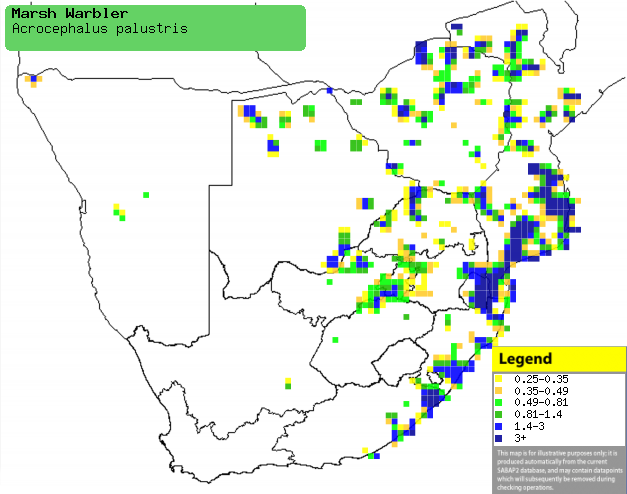|
Acrocephalus palustris (Marsh
warbler, European marsh-warbler)
Europese rietsanger [Afrikaans]; Bosrietzanger [Dutch];
Rousserolle verderolle [French]; Sumpfrohrsänger [German];
Felosa-palustre [Portuguese]
Life
> Eukaryotes >
Opisthokonta
> Metazoa (animals) >
Bilateria >
Deuterostomia > Chordata >
Craniata > Vertebrata (vertebrates) > Gnathostomata (jawed
vertebrates) > Teleostomi (teleost fish) > Osteichthyes (bony fish) > Class:
Sarcopterygii (lobe-finned
fish) > Stegocephalia (terrestrial
vertebrates) > Tetrapoda
(four-legged vertebrates) > Reptiliomorpha > Amniota >
Reptilia (reptiles) >
Romeriida > Diapsida > Archosauromorpha > Archosauria >
Dinosauria
(dinosaurs) > Saurischia > Theropoda (bipedal predatory dinosaurs) >
Coelurosauria > Maniraptora > Aves
(birds) > Order: Passeriformes
> Family: Sylviidae > Genus: Acrocephalus
Distribution and habitat
A Palearctic breeding migrant, its breeding grounds stretch
across much of Eurasia. In the non-breeding season it flies south to sub-Saharan
Africa, specifically from the Horn of Africa through Tanzania, Kenya and Zambia
to southern Africa. Here it is common but difficult to see, often skulking and
calling in dense, tangled undergrowth with the tree canopy up above, as its
preferred habitat is woodland. It may occasionally occur in garden hedges,
fields of sorghum and patches of tall grass.
|
 |
|
Distribution of Marsh warbler in southern Africa,
based on statistical smoothing of the records from first SA Bird Atlas
Project (©
Animal Demography unit, University of
Cape Town; smoothing by Birgit Erni and Francesca Little). Colours range
from dark blue (most common) through to yellow (least common).
See here for the latest distribution
from the SABAP2. |
Movements and migrations
The adults leaves their breeding grounds around
June-July; juveniles depart about a month later. It flies further
south to north-eastern Africa, probably staying there for the next
2-4 months before continuing its journey south, eventually reaching
southern Africa typically from December-January, sometimes earlier.
Its departure from this region is rapid, with most individuals
leaving in late March and early April.
Food
It mainly forages in the tree canopy, gleaning
invertebrates such as
spiders, snails, mosquitoes,
termites and other insects from leaves and branches.
Threats
Not threatened, in fact its range has expanded in the last
few decades, too the point that its population is now estimated to be in the
millions and increasing.
References
-
Hockey PAR, Dean WRJ and Ryan PG 2005. Roberts - Birds of
southern Africa, VIIth ed. The Trustees of the John Voelcker Bird Book
Fund, Cape Town.
-
Harrison, J.A., Allan, D.G., Underhill, L.G., Herremans, M.,
Tree. A.J., Parker, V. & Brown, C.J. (eds). 1997. The atlas of southern
African birds. Vol. 2: Passerines. BirdLife South Africa, Johannesburg.
|
